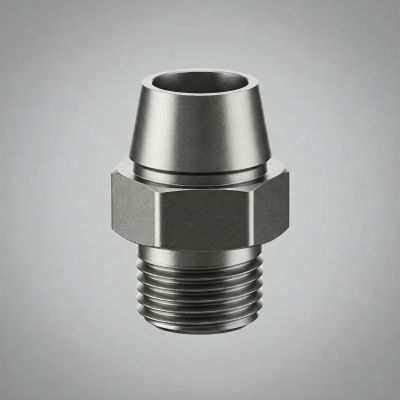Inverted flare threads are commonly used in automotive, hydraulic, and fuel systems due to their reliability and ability to create a secure, leak-free seal. These fittings are designed to handle high-pressure applications and provide a durable connection between tubing and components.
Choosing the right fitting for an inverted flare thread is crucial to maintaining the integrity of the connection, preventing leaks, and ensuring safety in various applications. In this guide, we will explore what fittings work best with inverted flare threads, how to identify them, installation steps, and troubleshooting tips.
Understanding Inverted Flare Threads
Inverted flare threads feature a conical seat that compresses against a corresponding fitting to create a secure, high-pressure seal. The design allows for repeated connections and disconnections without compromising the integrity of the seal.
How Inverted Flare Fittings Differ from Other Thread Types
Unlike NPT (National Pipe Thread) fittings, which rely on tapered threads for sealing, inverted flare fittings use a mechanical seal at the flare seat. This design reduces the need for thread sealants and ensures a more reliable connection in high-pressure environments.
Common Applications
➡️ Automotive Brake and Fuel Systems – Used in hydraulic brake lines and fuel delivery systems.
➡️ Hydraulic Systems – Found in industrial and agricultural hydraulic machinery.
➡️ Refrigeration Systems – Used in cooling and HVAC applications where leak prevention is critical.
Types of Fittings Compatible with Inverted Flare Threads
Inverted Flare Fittings
➡️ Specifically designed to mate with inverted flare threads.
➡️ Typically used in automotive, fuel, and hydraulic applications.
Adapter Fittings
➡️ Convert inverted flare connections to other thread types such as:
-
AN (Army-Navy) fittings
➡️ Useful for adapting systems with mixed connection types.
Hose Fittings
➡️ Allow for the integration of flexible hoses in fuel or hydraulic systems.
➡️ Ensure a secure connection while maintaining flexibility in the system.
Brass vs. Steel Fittings
➡️ Brass Fittings: Commonly used in low- to medium-pressure applications due to corrosion resistance and ease of installation.
➡️ Steel Fittings: Preferred for high-pressure and heavy-duty applications due to their strength and durability.
How to Identify the Right Fitting for an Inverted Flare Thread
Measuring Thread Size and Pitch
➡️ Use a thread gauge to determine the exact thread size and pitch.
➡️ Ensure compatibility by cross-referencing with manufacturer specifications.
Checking Seat Angles
➡️ Inverted flare fittings typically have a 45-degree seat angle.
➡️ Ensure the mating fitting has the same seat angle for a proper seal.
SAE Standards vs. Other Standards
➡️ The Society of Automotive Engineers (SAE) sets standards for inverted flare fittings.
➡️ Verify fittings meet SAE J512 or J513 standards for automotive and hydraulic applications.
Step-by-Step Guide to Installing an Inverted Flare Fitting
Tools Required
➡️ Flare nut wrench
➡️ Thread gauge
➡️ Pipe cutter (for tubing adjustments)
➡️ Deburring tool
Installation Process
1. Prepare the Tubing – Cut to length and deburr the edges.
2. Insert the Flare Nut – Slide the flare nut onto the tube before flaring.
3. Flare the Tube End – Use a flaring tool to create a 45-degree flare.
4. Align and Connect the Fitting – Ensure proper seating and hand-tighten the connection.
5. Secure with a Wrench – Use a flare nut wrench to tighten without over-torquing.
Common Mistakes to Avoid
➡️ Over-tightening, which can damage the flare.
➡️ Using mismatched fittings.
➡️ Not properly deburring the tubing before flaring.
Comparing Inverted Flare Threads with Other Thread Types
Inverted Flare vs. NPT Threads
➡️ Inverted Flare: Seals at the flare seat, requires no thread sealant.
➡️ NPT Threads: Seals through tapered threads, often requires sealant.
Inverted Flare vs. AN Fittings
➡️ AN Fittings: Similar 37-degree flare but not directly interchangeable with 45-degree inverted flare.
➡️ Inverted Flare: Designed for automotive and hydraulic systems.
When to Use an Adapter
➡️ If transitioning between different thread types in a system.
➡️ To retrofit modern fittings into older systems.
Common Issues and Troubleshooting for Inverted Flare Connections
Leaks at the Fitting Connection
➡️ Possible causes:
-
Improper flare angle.
-
Over-tightening or under-tightening.
-
Damaged flare surface.
➡️ Fix: Re-flare the tube or replace the fitting if damage is present.
Thread Damage and How to Repair It
➡️ Use a thread chaser or re-threading tool to clean up minor thread damage.
➡️ If threads are too damaged, replace the fitting.
Signs of Wear and When to Replace Fittings
➡️ Visible cracks or corrosion.
➡️ Difficulty tightening or achieving a secure seal.
➡️ Frequent leaks even after reinstallation.
Choosing the Best Inverted Flare Fittings for Your Application
Industry-Specific Recommendations
➡️ Automotive: Use SAE-compliant brass or steel inverted flare fittings.
➡️ Hydraulic Systems: Opt for high-pressure steel fittings for durability.
➡️ Fuel Systems: Ensure fittings are rated for fuel resistance and pressure.
Tips for Purchasing the Right Fittings
➡️ Always check for SAE compliance.
➡️ Verify material compatibility with the intended application.
➡️ Buy from reputable manufacturers to ensure quality.
Conclusion
Inverted flare threads provide a reliable and leak-free connection for high-pressure applications. Selecting the right fitting is crucial for ensuring performance, safety, and longevity in automotive, hydraulic, and fuel systems.
By understanding the types of fittings available, how to properly install them, and how to troubleshoot common issues, you can maintain a secure and efficient system. Always verify compatibility before purchasing and installing fittings to achieve the best results.
Post time: Apr-04-2025


